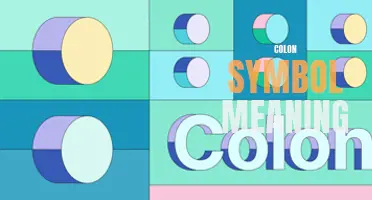
Symbols have been used throughout human history to convey meaning and communicate ideas that surpass the limitations of language. From ancient civilizations to modern societies, symbols have been deeply ingrained in our culture, serving as a shared language that transcends time and geography. Whether it's an emblem representing a nation's identity, a religious symbol inspiring faith, or a secret code hidden in works of art, symbols have the power to connect us, provoke emotions, and leave a lasting impact. In this exploration of meaningful symbols and their rich and varied meanings, we will delve into the depths of symbolism, unlocking the hidden messages and layers of significance that have fascinated humanity for centuries.
What You'll Learn
- What are some examples of symbols that have deep meaning across different cultures?
- How does the interpretation of a symbol vary depending on the individual or culture?
- Can symbols have multiple meanings or interpretations?
- How can symbols be used to convey complex ideas or emotions?
- Are there any symbols that have lost their original meaning over time?

What are some examples of symbols that have deep meaning across different cultures?
Symbols are powerful tools for communication and representation. They have the ability to convey complex ideas, emotions, and concepts in a concise and visual manner. While many symbols have specific meanings within a particular culture, some symbols have deep meaning across different cultures. These symbols often transcend cultural boundaries and are universally recognized and understood. Here are some examples of such symbols:
The Lotus Flower:
The lotus flower is a significant symbol in various cultures, including Hinduism, Buddhism, and Ancient Egyptian mythology. In all these cultures, the lotus flower represents purity, enlightenment, and spiritual awakening. The lotus flower grows in muddy water but rises above it to bloom, symbolizing the journey from darkness to enlightenment and the ability to overcome obstacles.
The Ying and Yang:
The Yin and Yang symbol is derived from Chinese philosophy and represents the concept of duality and balance. The symbol consists of two interconnected shapes, one black and one white, with a dot of the opposite color in each section. This symbolizes the idea that opposing forces are interconnected and interdependent, and that balance can only be achieved when these forces are in harmony.
The Cross:
The cross is one of the most globally recognized symbols, representing Christianity and its central figure, Jesus Christ. It symbolizes sacrifice, redemption, and faith. However, the cross also has significance in other cultures and religions, such as ancient Egyptian and Celtic cultures. In these contexts, the cross symbolizes life, fertility, and protection.
The Om Symbol:
The Om symbol is a sacred sound and a spiritual icon in Hinduism, Buddhism, and Jainism. It represents the divine and the ultimate reality. The symbol consists of three curves, a semi-circle, and a dot, symbolizing the infinite and the formless nature of the universe. It is often chanted during meditation and is associated with peace, harmony, and enlightenment.
The Eye of Horus:
The Eye of Horus is an ancient Egyptian symbol, also known as the Udjat or the Eye of Ra. It represents protection, healing, and power. The symbol is believed to have magical properties and was used as an amulet to protect against evil and to bring prosperity. It is often depicted as a stylized eye with markings that resemble a falcon, representing the god Horus.
The Hamsa:
The Hamsa is a hand-shaped symbol that has deep meaning in various cultures, including Judaism, Islam, and Christianity. It is believed to bring protection against the evil eye and is a symbol of good luck, abundance, and blessings. The Hamsa is often decorated with an eye in the center, known as the "eye in the hand," representing divine protection and guidance.
These symbols are just a few examples of the universal language that symbols can speak. They serve as a means of connection and understanding between different cultures, bridging gaps and fostering mutual respect. These symbols remind us of our shared human experiences and the values we hold dear, transcending boundaries and creating a sense of unity among diverse cultures.
Understanding the Meaning of Honda CR-V Dashboard Symbols: A Comprehensive Guide
You may want to see also

How does the interpretation of a symbol vary depending on the individual or culture?
Symbols hold significant meaning in human culture. They can represent complex ideas and emotions and can vary in interpretation depending on the individual or culture. The interpretation of a symbol is influenced by various factors such as personal experiences, social and cultural background, and even language.
The process of interpreting symbols begins with the recognition of the symbol itself. This recognition is based on individual experiences and knowledge. For example, a red heart shape is universally recognized as a symbol of love and affection. However, the interpretation of this symbol can vary depending on the cultural context. In Western cultures, the heart symbol is associated with love and romance, while in other cultures, it may represent different emotions or concepts.
Personal experiences also play a significant role in symbol interpretation. A symbol can trigger different emotions and memories for different individuals based on their personal experiences. For instance, a flag can elicit feelings of pride and patriotism for one person, while for another, it may remind them of a traumatic event related to war or conflict. Similarly, religious symbols hold different meanings for people of different faiths and may evoke contrasting emotions or beliefs.
Social and cultural background is another important factor that influences symbol interpretation. Different cultures often attribute different meanings to certain symbols. For example, the color white can symbolize purity and innocence in Western cultures, but in some Eastern cultures, it represents mourning and death. Similarly, the lotus flower is considered a symbol of purity and enlightenment in Buddhist cultures, while in ancient Egypt, it symbolized rebirth and creation.
Language also plays a role in symbol interpretation. The meaning of certain symbols can be influenced by the language used to describe them. For example, in English, a snake is often associated with deceit and danger. However, in some Native American cultures, a snake can symbolize healing and transformation. The same symbol can have different interpretations depending on the language used to describe it.
In conclusion, the interpretation of a symbol can vary depending on the individual or culture. Factors such as personal experiences, social and cultural background, and language play a significant role in shaping the meaning and understanding of symbols. Symbols hold a powerful influence on human communication and can evoke a range of emotions and ideas, making them an essential aspect of culture and human interaction.
Decoding the Symbolism: Unraveling the Meaning behind the Crosshairs Symbol
You may want to see also

Can symbols have multiple meanings or interpretations?
Symbols are powerful tools that can convey multiple meanings or interpretations depending on the context in which they are used. Whether they are visual, written, or spoken, symbols have the ability to evoke emotions, communicate ideas, and convey complex concepts in a concise and memorable way.
Symbols have been used throughout history in various cultures and societies. For example, the yin and yang symbol in Chinese philosophy represents the concept of balance and harmony between opposing forces. It can be interpreted as representing the balance between masculine and feminine energies, light and dark, or good and evil.
Similarly, the swastika symbol, which was originally a religious symbol in ancient cultures, later became associated with hate and genocide due to its appropriation by the Nazi regime during World War II. The meaning of this symbol drastically changed depending on the historical context and the actions of those who utilized it.
Symbols can also have different interpretations based on an individual's personal experiences, beliefs, and cultural background. For example, the heart symbol is commonly associated with love and affection in Western cultures. However, in some Asian cultures, the heart symbol may be interpreted as representing the mind or intellect instead.
Furthermore, symbols can have different meanings within different fields or areas of study. For instance, the symbol of a dove is often used to represent peace and tranquility in a cultural or social context. However, within the realm of ecology and environmentalism, a dove might be seen as a symbol of a species that has adapted well to human-altered environments, serving as a reminder of the impacts of human activities on wildlife populations.
Language and the use of symbols are closely intertwined. Through the use of words and symbols, humans can express complex ideas and emotions. However, this also means that symbols can be open to interpretation and misinterpretation. Cultural symbols, such as flags or religious icons, can provoke strong emotions and differing interpretations depending on an individual's perspective.
Symbols can also be used in art and literature to convey deeper meanings and evoke emotions. Artists and writers often employ symbolism to add layers of meaning to their work and encourage viewers or readers to engage in a deeper level of interpretation. For example, the red rose is often used as a symbol of love and passion in poetry and literature.
In conclusion, symbols have the ability to convey multiple meanings or interpretations. Their meaning can change depending on the historical context, individual experiences, cultural background, and the field or area of study in which they are being used. Symbols are powerful tools that allow us to communicate complex ideas and emotions in a concise and memorable way.
Decoding the Hidden Meaning Behind the Wifi Symbol
You may want to see also

How can symbols be used to convey complex ideas or emotions?
Symbols have long been used as a means of communication and expression. They can convey complex ideas and emotions in a way that words alone often cannot. Whether it is a simple icon or a more elaborate piece of artwork, symbols have the power to evoke strong emotions and convey deep meaning.
One way symbols can convey complex ideas is through their use in language and literature. For example, a red rose is often used to symbolize love or passion, while a black cat is frequently associated with bad luck. These symbols can be easily understood and recognized, allowing the reader to quickly grasp the concept or emotion being conveyed.
Symbols can also be used in art and visual media to convey complex ideas or emotions. For instance, the use of dark, foreboding imagery in a painting or photograph can evoke a sense of fear or danger. Similarly, bright, vibrant colors may be used to represent joy or happiness. The artist can use these symbols to create a specific mood or atmosphere and convey the intended meaning to the viewer.
In addition to their use in language and art, symbols can also be used in cultural rituals and ceremonies to convey complex ideas and emotions. For example, in many cultures, a wedding ring is seen as a symbol of love and commitment. By exchanging rings, the couple is symbolically expressing their devotion to one another. Similarly, the use of certain symbols in religious ceremonies can convey a sense of spirituality or transcendence.
Symbols can also be used to convey complex political or social ideas. For instance, the American flag is a powerful symbol of patriotism and unity. When people see the flag, it can evoke feelings of pride and loyalty to their country. Similarly, symbols such as the peace sign or the raised fist can represent specific political movements or ideologies.
Symbols can be particularly effective in conveying complex ideas or emotions because they tap into the subconscious mind. They can bypass rational thought processes and speak directly to our emotions and intuitions. This is why symbols are often used in advertising and marketing to create a specific response or association with a product or brand.
In conclusion, symbols have the power to convey complex ideas and emotions in a way that words alone cannot. Whether used in language, art, rituals, or politics, symbols can evoke strong emotions and convey deep meaning. They tap into our subconscious minds and speak directly to our emotions and intuitions, making them a powerful tool for communication and expression.
Understanding Crochet Symbols: Their Meaning and Usage
You may want to see also

Are there any symbols that have lost their original meaning over time?
Symbols have played a significant role throughout history, representing various meanings and concepts. However, as time progresses and society changes, certain symbols have lost their original meaning. This article will explore some symbols that have experienced a shift in their significance over time.
One example of a symbol that has lost its original meaning is the swastika. The swastika was originally a sacred symbol in many Eastern religions, representing well-being and good fortune. However, with the rise of Nazi Germany in the 20th century, the swastika became synonymous with hate, racism, and the atrocities committed during the Holocaust. As a result, the original meaning of the swastika has been largely forgotten, and it is now universally associated with the horrors of the Nazi regime.
Another symbol that has lost its original meaning is the peace sign. The peace sign, which incorporates a circle with downwardly pointed lines forming a triangle, was designed in 1958 as a symbol of nuclear disarmament. It quickly gained popularity during anti-war movements, particularly during the Vietnam War. However, over time, the peace sign has been commercialized and mainstreamed to the point where its original association with peace and anti-war activism has been diluted. Today, the peace sign is often used in fashion and popular culture without any connection to its original purpose.
The Christian cross is another symbol that has lost some of its original meaning. The cross, representing the crucifixion of Jesus Christ, was once a powerful symbol of sacrifice, redemption, and faith. However, in recent times, the cross has become a fashion accessory, often worn as a trendy piece of jewelry without any religious significance. This commercialization and popularization of the cross have led to a loss of its original religious meaning for many people.
Similarly, the LGBT rainbow flag has also experienced a shift in its meaning. Originally designed in the late 1970s as a symbol of unity and pride for the LGBTQ+ community, the rainbow flag has become more widely recognized and adopted in mainstream culture. While this increased visibility has been positive in many ways, it has also resulted in the dilution of the flag's original meaning. Today, the rainbow flag is often used in marketing campaigns or as a decorative item, detached from its roots in the struggle for LGBTQ+ rights and equality.
In conclusion, symbols are not static and can evolve over time. The examples discussed above demonstrate how symbols can lose their original significance as societal contexts change. Whether it be due to commercialization, dilution of meaning, or appropriation, symbols can undergo a profound transformation in their interpretation and emotional impact. It is important to reflect on the original intent and historical context of symbols to truly understand their meaning and significance.
Understanding the Powerful Wiccan Symbols and their Profound Meanings
You may want to see also
Frequently asked questions
The yin-yang symbol is a meaningful symbol in Chinese philosophy that represents the balance and harmony between opposite forces in the universe. The dark side, or yin, represents femininity, passivity, and darkness, while the light side, or yang, represents masculinity, activity, and light. Together, they symbolize the interconnectedness and interdependence of all things. It is a reminder that no aspect of life exists in isolation and that every action has a consequence.
The lotus flower is a powerful and meaningful symbol in many cultures, particularly in Buddhism and Hinduism. It grows from muddy waters and rises above the surface to bloom beautifully, which represents the journey of spiritual growth and enlightenment. The lotus is often associated with purity, rebirth, and spiritual awakening. It serves as a reminder that even in the darkest and most challenging circumstances, one can still find beauty and achieve personal growth.
The infinity symbol, also known as the lemniscate, represents eternity, limitless possibilities, and infinite potential. It is a meaningful symbol often associated with concepts such as eternal love, endless cycles, and the interconnectedness of all things. The shape of the symbol, which resembles a figure eight on its side, signifies balance, harmony, and the merging of opposites. It serves as a reminder to embrace the infinite possibilities in life and to recognize the interconnected nature of our existence.
The Tree of Life is a meaningful symbol that appears in various cultures and religions throughout history. It represents the interconnection between all forms of life and the cycle of birth, growth, death, and rebirth. The tree's roots reach deep into the earth, symbolizing a strong foundation and connection to our ancestors, while its branches extend towards the sky, representing growth, abundance, and reaching towards higher knowledge. The Tree of Life serves as a reminder to appreciate the interconnectedness of all living beings and to strive for personal and spiritual growth.







